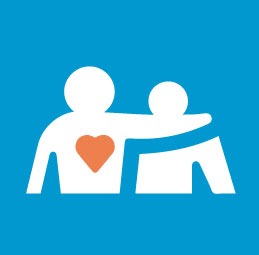Coping With Loss
Preparing an Autistic Person for Loss
It’s crucial for the support network of an autistic person, especially one who heavily depends on a parent or caregiver, to have a plan to help them prepare for and cope with death.
Here are some tips for preparing an autistic person for serious illness or death, how to communicate news of a loss, and ways to remember and memorialise the deceased:
For Autistic Children
and Young People
For
Autistic Adults
This process will be challenging, but you don’t have to face it alone. We strongly recommend seeking support from
individuals or groups who can help you through this emotional time.
Supporting Autistic Children and Young People
Prepare Your Child for Loss
Teaching before loss occurs
Death is a complicated and abstract concept. Use simple terms to describe death, for example, when someone dies, they can no longer breathe, move or eat. Explain death as a natural part of life using examples they can see, like a dead fly on the windowsill, or a plant’s life cycle.
You can also introduce the concept of death by using everyday situations, like the death of a co-worker or the death of someone famous. Let your child see how you react to loss to help them learn about emotions. If suitable, consider having your child attend a wake or funeral.
It may be helpful to prepare your child for your eventual death by talking about a future where you are no longer present with them. Films, books, news stories, stories of people they know or games can be used to start the conversation.
Be mindful that feelings of grief are not reserved for just people. The death of a beloved pet can evoke the same depth of sadness and grief as the loss of a friend or family member.
Begin with the illness
If the death of someone close is expected, gradually start preparing the child in advance. Explain what will happen at hospitals, funerals, and wakes. If possible, visit these places beforehand or look at pictures together to familiarise the child.
Before visiting hospitals/hospices, tell the child about any changes they might notice in the ill person, such as changes in appearance, sound, or feel. Explain the presence of medical equipment like intravenous lines or ventilators, and mention that these might be noisy
Maintain daily routines
Try to keep daily routines as close to the child’s usual routine as possible. If there are going to be changes, explain them clearly ahead of time. Tell the child who will be taking them to school or to their activities, using clear and concrete language. Use pictures and photographs to help explain new people or places, like a picture of the new babysitter or the hospital.
Use Social Stories
Preparing your child for your own passing or that of someone close can be very tough. Creating a Social Story in advance can help

How do I make Social Stories?
These Social Stories can be helpful to prepare the child for visits to the hospital/hospice, funerals and wakes. The story should include significant details (e.g. what the coffin will look like, what the body will look like, that people may be crying, etc.) Where appropriate, generic images should be replaced with actual photos (e.g. photos of hospital, church etc).
Think about asking specific people to take photos and videos at the funeral. These can remind your child of what occurred and can be added to the Social Story you prepare.
“Facing the Subject of Death Head-on”
Click to read about Jacquelyn Ang’s moving account with a high support needs autistic child here.
Communicating News of a Loss
Talk about the situation, don’t avoid it
When talking to your child about death, use clear and straightforward language. Instead of saying that someone has “gone to a better place” or “gone to sleep,” clearly explain that they have died.
Clarifying death is important because vague explanations can lead your child to misunderstand why the person is no longer present. For example, your child might think the person they love is gone for other reasons, such as the person left because they no longer love them.
If your belief system includes concepts like Heaven, be clear that Heaven isn’t a place you can visit, like a city on a map. This helps prevent your child from feeling confused or upset about why they can’t go there to see their loved one or why the person isn’t coming back to visit.
Provide Comfort and Reassurance
If someone close to your child dies, your child may worry about losing you too. It’s important to reassure them that you are still there to care for them and that there are other supportive people in their life.
Monitor how often your child seeks reassurance. It’s normal for them to need extra comfort during this time, but be aware if it starts to turn into compulsive behaviour. If it does, address this gently to promote healthy coping
Find Ways to Remember
When a child loses someone important like a parent or caregiver, remembering that person is a key part of dealing with grief. Even if the person isn’t physically there anymore, the emotional bond is still strong. Memories help the child understand who they’re grieving for and why.
Encourage the child to talk about the person who has passed away. Explain that it’s okay to miss them and share memories, even if they can’t see or talk to them anymore. Give the child plenty of chances to express their feelings and thoughts.
You can also help by sharing your own memories and feelings about the person. Look at pictures together and tell stories about them. Remember, it might take a while for the child to fully understand their loss, and they may want to talk about it even much later

Personal items
A piece of fabric from the deceased’s clothing can be kept in a pocket or made into a cushion for comfort.

Create a memory box
The box can include the following but are not limited to:
- Letters and messages for your child to listen to, watch or read after the funeral
- Recordings and videos of them and your child
- A memory stick with videos or music loved by the deceased,
- Photographs of your child and the deceased loved one doing ordinary things together
- Personal objects that were special to the deceased and items with their scent like perfume.

Sensory Reminders
Try to include items that the child can look at, hear, smell and touch when they miss their deceased loved one.

Visual Timeline
Organising photographs to create a timeline helps spark memories of significant events and build a life story of the person.
These activities and items can provide meaningful ways for grieving children and young people to connect with and remember someone important who has passed away.
Other Reading
For
Autistic Adults
Supporting Autistic Adults
Preparing for Loss
Educate
Before attending a funeral or any ceremony related to death, it’s important to clearly explain to your loved one with autism what will happen. People with autism often take things literally, so explain directly if the deceased will be buried or cremated, and what they might see, such as a coffin or an urn. Visiting the venue beforehand to familiarise them with the environment can be helpful.
Religious beliefs about the afterlife, like angels or Heaven, can be comforting to some but confusing to others due to their abstract nature. Tailor the explanation to what seems most helpful for the individual.
Communicate
Use clear and straightforward language when discussing what will happen at the event, detailing what and who they may see, hear, feel and smell. Prepare them for potential social interactions, such as receiving condolences, and discuss appropriate attire and how they might want to participate, making sure they are comfortable with physical contact and social norms.
Model
If needed, show them how to respond to common interactions they will encounter, like people offering condolences. Practising these responses can lessen social anxiety and prepare them for the types of comments and gestures they might encounter at the event.
Offer Choices
Let your loved one choose how much they want to be involved in the ceremony. Clearly explain what will happen, like praying, kneeling, or chanting. Always give them options so they can join in a way that feels comfortable to them. Everyone deserves the chance to say goodbye in their own way.
Support
Ensure they have supportive people around them during the event, particularly if their usual support network will be busy.
Plan ahead for their needs, such as scheduling breaks or having comfort items like fidget tools.
Process
After the event, be available to help them process their experiences. Respect their pace and willingness to share their thoughts and emotions, providing a supportive and understanding environment as they deal with their feelings.
Communicating News of Loss
Delivering the News
When sharing news of a death with someone who has autism, use clear, honest language to ensure they understand what has happened. Instead of using softer terms like “passed away,” use direct words like “died” for more clarity. Adapt your explanations to their level of understanding
Understand Their Reaction
Don’t expect a typical reaction. Individuals with autism might appear calm but could be experiencing intense internal reactions. They might lose their ability to communicate, not show their emotions, withdraw, or even ignore the news.
Remember, each person and their way of handling news can be different.
Learn from the Past
Reflect on what communication methods have worked before with this person. Use your knowledge of their needs to guide how you break the news, whether it’s about death or serious illness.
Provide Reassurance
Assure them that their feelings are valid and that support will continue. Explain that their relationship with the deceased can still be honoured through memories, traditions, and behaviours, even if it might not seem logical to them.
Find Ways to Remember
Remembering a loved one who has passed away can bring comfort by feeling a connection to them, though it can also be painful, especially soon after the death. Here are several ways to remember someone, which you can share with the autistic person you support. Keep in mind, what brings comfort can vary greatly from person to person and may change over time

Keep Photos
Having photos of the deceased can remind you of happy times together, though for some, it may be a painful reminder.

Wear Their Items
Wearing clothing or jewellery of the deceased, like a shirt, or a favourite ring, can help feel a connection by recalling their scent or shared moments.

Create Art or Writing
Writing a letter, poem, or drawing about the deceased can help express feelings. This can be shared with others or kept private.

Share Memories
Talking about special moments with the deceased can help keep their memory alive.

Visit Meaningful Places
Going to the cemetery or places the deceased valued can offer a sense of closeness.

Use Social Stories
remembering loved ones.
Other Reading
For Autistic Children
and Young People

